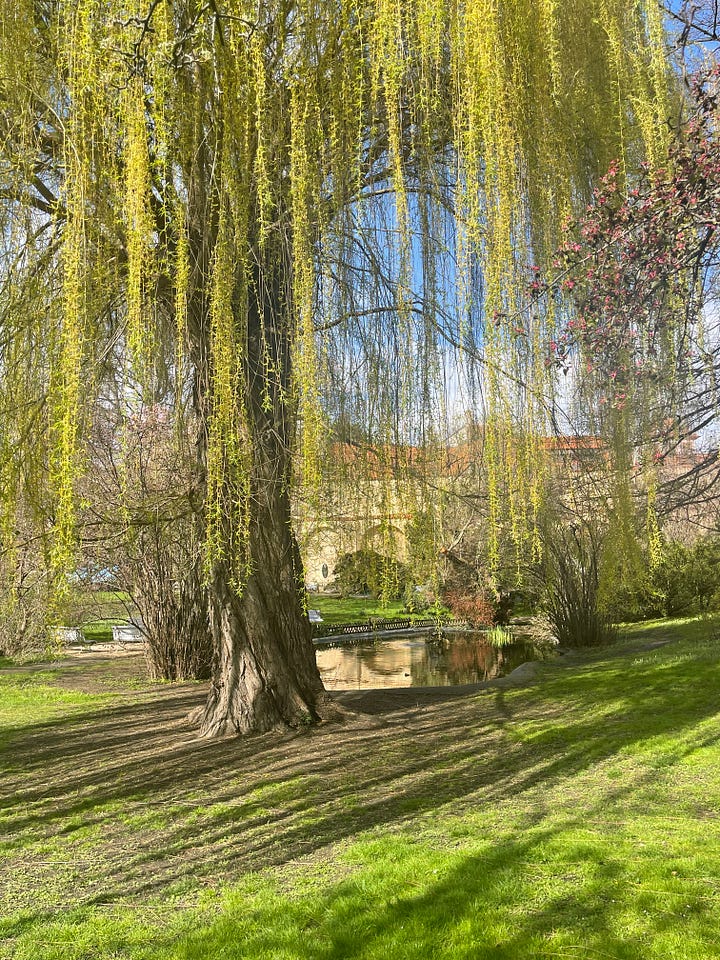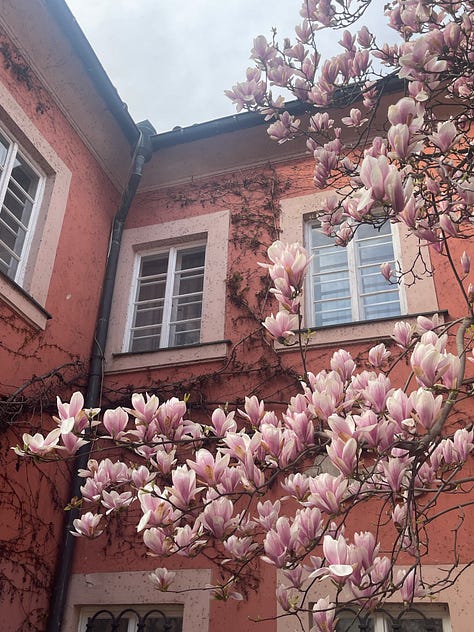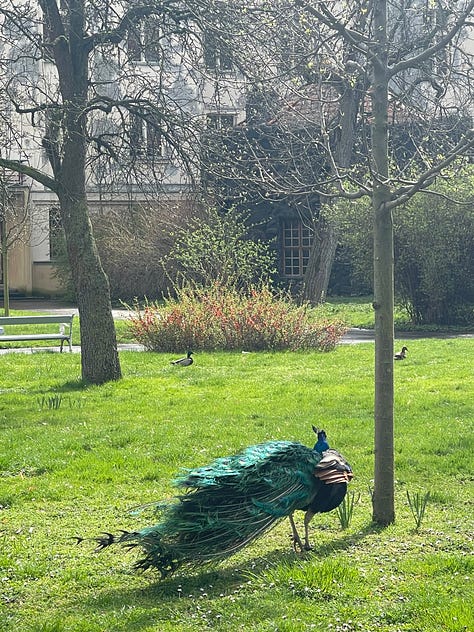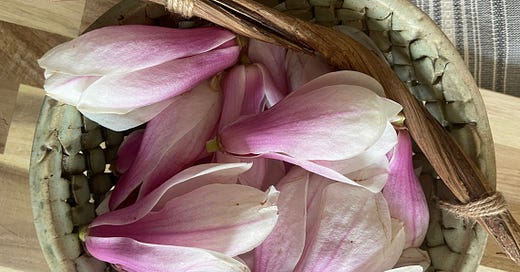The Peacocks of Vojanovy Park When There Were No Tourists In Prague
plus a jar of pickled magnolia blossoms
The deeper the experience of an absence of meaning — in other words, of absurdity — the more energetically meaning is sought. - Václav Havel
For three years, I lived in Prague. I arrived just at the tail-end of the pandemic, and the city, the one that had become shorthand for over-tourism, had emptied out. Charles Bridge, built in the 14th century under King Charles IV and once the only bridge crossing of the Vltava River, became my private morning walk. The baroque statues lining the bridge, usually obscured by tourists, were cast in early amber light and river fog. On some days, it felt like they were the only ones watching me walk.
Wenceslas Square, which is less a square than a grand boulevard, has always been a stage for Czech history. It was here that crowds surged during the Velvet Revolution in 1989, when Czechoslovakia peacefully ended four decades of communist rule. It’s where Jan Palach set himself on fire in 1969 in protest of the Soviet occupation. During my first winter there, it stood in rare silence. Not a person in sight. Later on in my stay, when the war in Ukraine broke out, it once again filled with a hundred thousand people waving flags, crying, shouting in solidarity. The contrast was sharp, surreal, and inspiring.




Old Town Square was no different. This was once the heart of medieval Prague, a marketplace since the 12th century, ringed with Gothic and baroque facades. Tyn Cathedral, arguably the city’s most iconic landmark, looms dramatically behind, its twin towers said to have inspired Disney’s castle (though the church’s dark Gothic presence is far more brooding than anything in Fantasyland). During lockdown, it was silent. You could hear your own footsteps on the cobblestones. You could imagine the city as it was, before it became a photo-op with a hefty price tag.
When the crowds returned, they returned in numbers Prague had never seen before. The Charles Bridge was reduced to its usual catwalk of influencers with selfie-sticks. Wenceslas Square was shoulder-to-shoulder. And Old Town Square again buzzed with tourists waiting beneath the Astronomical Clock, jostling for position, holding up their phones to the clock, eager to catch its hourly procession of saints, as if it were a theme park animatronic show.
Even the trdelník (pronounced trr-del-neek and also referred to as a chimney cake) was corrupted. It’s not even Czech in origin, but a pastry from Transylvania with Hungarian roots. Traditionally, it’s cooked over a wood fire on a rotating spit and sprinkled with sugar and cinnamon. But in Prague’s tourist epicenter, it has morphed over the years into a sugary chimera stuffed with Nutella, ice cream, M&Ms, smashed Kit Kats, or everything all at once. It’s not the kind of thing you eat once for a selfie, not twice for taste.
And yet, beyond the Bohemian spectacle, quiet corners endure in Prague.
I walked constantly during that strange time. Up into Letná Park to overlook the city from above the Vltava’s bend. Into Divoká Šárka, a wild valley still within the city limits, where hawks soar overhead and you can forget you’re in the busy capital. And often, into Vojanovy Park, a place so close to the crowds, it seems to repel them in its easy proximity.
Vojanovy Park is technically Prague’s oldest garden, part of a monastery founded by the Sisters of the Order of Saint Ursula in the 17th century. The land had been cultivated even earlier, originally belonging to a vineyard mentioned in 13th-century history books. Today, it’s a tucked-away sliver of green, just off Karmelitská Street in Malá Strana, a literal stone’s throw from the bridge most tourists cross. A high wall surrounds it, and the entrance isn’t obvious. You could walk by a dozen times and never realize what’s behind the gates.
Step inside, and you’ll find twisting gravel paths, ornamental ponds, a weeping willow that sways softly in a breeze, and gnarled trees that lean over benches worn smooth by time. There are baroque sculptures nestled under the ivy, and the remains of a chapel wall. The garden’s quirky beehives, each topped with a carved wooden head, watch silently, like guardians of this small, walled, wonderfully private world.
And then there are the peacocks.



They’re not ornamental. They live here. They wander freely, dragging their iridescent tails through the flowerbeds, and cry out in humanlike voices to break the park’s silence. In the spring, they strut beneath the magnolia trees, which bloom explosively all throughout the city for a few short weeks. The petals are thick, waxy, flushed with pink, and when they fall, they carpet the grass like a scene from a Kurosawa movie. Magnolia season in this peacock-filled park looks staged, but it isn’t. This is just what thankfully happens here in late spring!
One morning in the park, I saw an older woman with a woven foraging basket, the kind Czechs take into the forest each year in search of mushrooms, wild garlic, or rosehips or on their weekly shop at the farmers’ market. Her basket was full of magnolia blossoms. I asked, in a clumsy mix of Czech and miming, what she planned to do with them.
She smiled, mimed a jar, and said “na salát.”
Pickled, for salads.
It made perfect sense. Magnolia petals have a crispness and a subtle bitterness that works really well in brine. In China and Korea, the buds and blossoms are used in everything from teas to pancakes to rice cakes. In Japan, magnolia leaves are sometimes grilled and used as a platter for miso-glazed vegetables. But in Czech kitchens, the use is more seasonal, more intuitive.
Not written down so much as passed down. It was the kind of answer that reminded me that foraging here isn’t a trendy lifestyle, it’s a rhythm that Czechs have incorporated into their daily lives for generations. A way of marking time and seasons with what the land, even in a park tucked away in a busy city. gives them.
So the next day, I brought my own basket. I foraged while the peacocks watched, indifferent to my ambition, and made my way home through the Charles Bridge crowds to pickle my blossoms.
Magnolia season doesn’t last long. But while it’s here, there are few better ways to capture it than in a jar. If you find yourself in Prague during spring, don’t fight the crowds on the bridge. Walk a little farther. Look for the plain gate just off Karmelitská. Slip inside. The peacocks will be there. The blossoms too, if it’s springtime. And for a little while, maybe even the silence.
News & Favorites
The Storied Table: The Storied Table is a new event series a long time in the making, inspired by the research and travel behind my recent cookbooks Elysian Kitchens and Eat Like a Monk. Through those books, I spent time in monasteries, temples, and sacred spaces around the world, learning how food can be a quiet act of devotion, connection and community. The Storied Table brings those experiences to life, offering communal meals from regional chefs and food producers in extraordinary places that carry their own sense of ritual, history, and beauty. We’re currently lining up a series of upcoming events (Minnesota, Morocco, Ireland, Korea, Japan, Portugal and Spain are a few of the locations where we’re currently planning), with tickets for the inaugural gatherings going on sale July 1st. I’ll be sharing more about the inspiration and vision in future posts, but in the meantime, you can explore what we’re building at thestoriedtable.co and our Instagram.
101 Fantasy Feasts: A few weeks ago, I launched my new newsletter, 101 Fantasy Feasts. Every Friday, I’ll share one chapter from 101 Fantasy Feasts (so far, my favorite feasts from the movie and book Chocolat and The Green Wedding from Game of Thrones have been featured). It’s a project that includes 101 feasts inspired by the most iconic meals from film, television, and literature, reimagined as real-life gatherings you can recreate. From the whimsical to the dramatic, each feast includes menus, setting details, party ideas, and five original recipes. It’s been a true labor of love (a project that I started on a whim during the pandemic when I missed gathering with people that now includes 101 feasts!), and I’m excited to finally begin sharing it with you. This series will run alongside my regular weekly newsletter, so you’ll still get your usual post, plus a little extra creative inspiration every Friday. This week it’s a full-on Italian feast inspired by one of my favorite movies (hint, Stanley Tucci!).
Eat Like a Monk: A Plant-Based Guide to Conscious Cooking and Mindful Eating: I had a book published last year by Simon & Schuster comprised of plant-based recipes primarily inspired by Buddhist monasteries throughout Asia. I wrote about Eat Like a Monk in a recent post that includes a few vibrant recipes from the book.
Swiss Recipes From Cuisine Helvetica: If you're curious about the flavors, traditions and evolving identity of Swiss cuisine, Cuisine Helvetica is a newsletter worth subscribing to. Written by food writer and cultural observer Heddi Nieuwsma, an American-Swiss pastry chef and cookbook author, the newsletter explores everything from regional specialties and culinary history to seasonal recipes and food-focused travel within Switzerland. It’s an engaging, deeply knowledgeable look at a cuisine that’s far more than fondue and chocolate, though both make tasty appearances!
Earth Day Book Recommendation: If you're looking for a powerful Earth Day read, The Overstory by Richard Powers is a sweeping, deeply affecting novel that reframes how we see the natural world, especially trees. Through interwoven narratives spanning time and geography, Powers explores the connections between humans and forests with a deeply moving emotional and ecological intensity that is a quiet call to action. It’s a book that doesn’t just tell a story, it shifts your perspective, urging you to listen more closely to the living world around you. For Earth Day or any day you’re craving something rooted, vast, and transformative, this is a must-read.
My newsletter is reader-supported.
Free subscribers get limited access to the weekly newsletter and two weeks worth of archives.
Paid subscribers get complete access to all of the content in my newsletters and my entire archives. You’ll also get all of the recipes, guides, interviews, cooking tips, essays and more, plus the ability to comment and participate in discussions.
Newsletters will arrive right in your Inbox or you can read them through the app.
Pickled Magnolia Blossoms
Crisp, tangy, and floral (but not overly perfumed). Pickled magnolia blossoms are shockingly easy to make and absurdly pretty in the jar, perfect on a plate of lentils, tossed with cucumber, sprinkled over a salad, or eaten straight from the jar with a glass of dry white wine.
Makes 1 liter jar
Prep & Cook Time: 20 minutes, plus a week to pickle
Ingredients:
2 heaping cups magnolia petals, cleaned by washing them gently under cold running water and then patting dry, and trimmed
1 cup mild vinegar (rice, white wine, or apple cider)
1 cup water
1 tbsp sugar
1 tsp salt
Optional: slices of ginger, a few peppercorns, or lemon peel
Bring the vinegar, water, sugar, and salt to a simmer. Pour the hot brine over the petals in a sterilized jar. Add aromatics, if using. Let cool to room temperature, seal, and refrigerate. They’ll be ready in a couple of days, better after a week, and will keep for several more. Serve them whole or thinly slice the petals using a sharp knife or a scissors for a garnish.
Expat Life: Advice, Tips, News and Encouragement
I relocated from America to Europe (right now I’m living in the northern Portuguese city of Braga) about four years ago and I’m always being asked what the experience has been like, how to do it, advice for making the process easier, and where to live.
It’s tricky, sometimes headache inducing, often nerve wracking, a bit baffling, but not impossible and at least for me, fulfilling, rewarding, and life enhancing. This weekly section explores what I’ve learned (and am continuing to learn) and highlights the most recent news and helpful advice for those who are thinking about exploring the expat life.
In this week’s edition of Expat Life: The UK’s Global Talent Visa
If you’re thinking about relocating to another country and bringing your career with you, the UK’s Global Talent Visa might be worth a closer look. Designed for individuals who are leaders or potential leaders in fields like academia, arts and culture, or digital technology, this visa offers a flexible pathway to live and work in the UK without needing a job offer in hand. It’s particularly appealing for creatives, researchers, and tech professionals who want autonomy and the ability to build a life in the UK on their own terms. The application process involves endorsement from an approved organization, but once granted, the visa (which is processed very quickly compared to many other visas) can lead to settlement and even citizenship.
Let’s Talk!
Please join the What’s Good Here community by posting a comment or to just say hello to get the conversation started!
Image attributions throughout the newsletter are mine, unless otherwise noted.
If you would like to learn more about me and discover what I will deliver to you each week through this newsletter, you can find that information here or check out my Instagram or website.







Hi Jody! Thanks so much for mentioning my new Swiss Recipes newsletter! -Heddi Nieuwsma (Cuisine Helvetica)